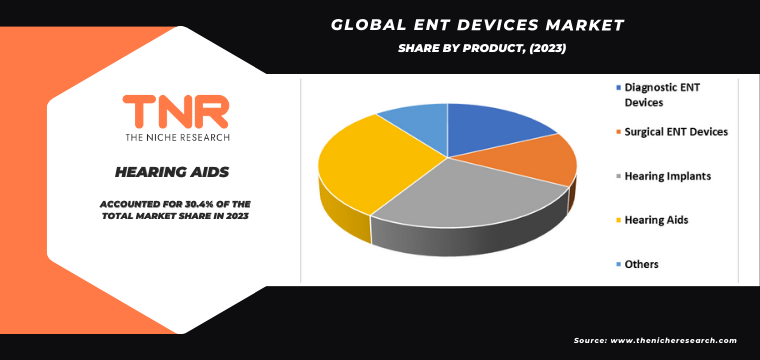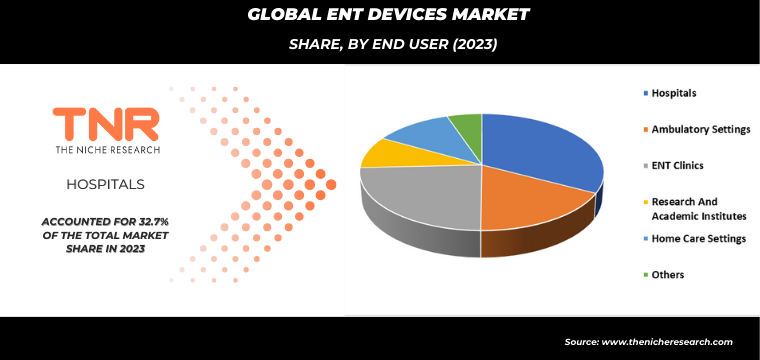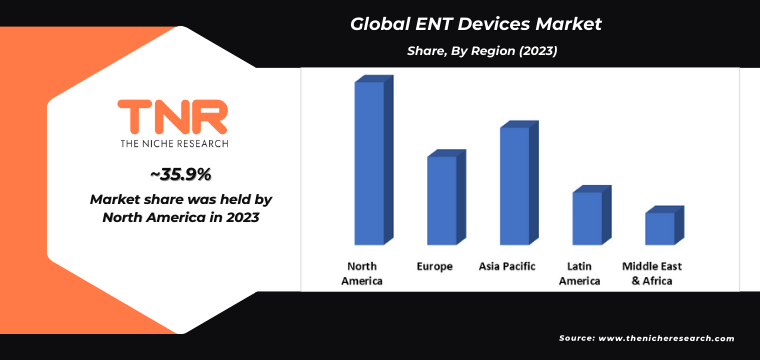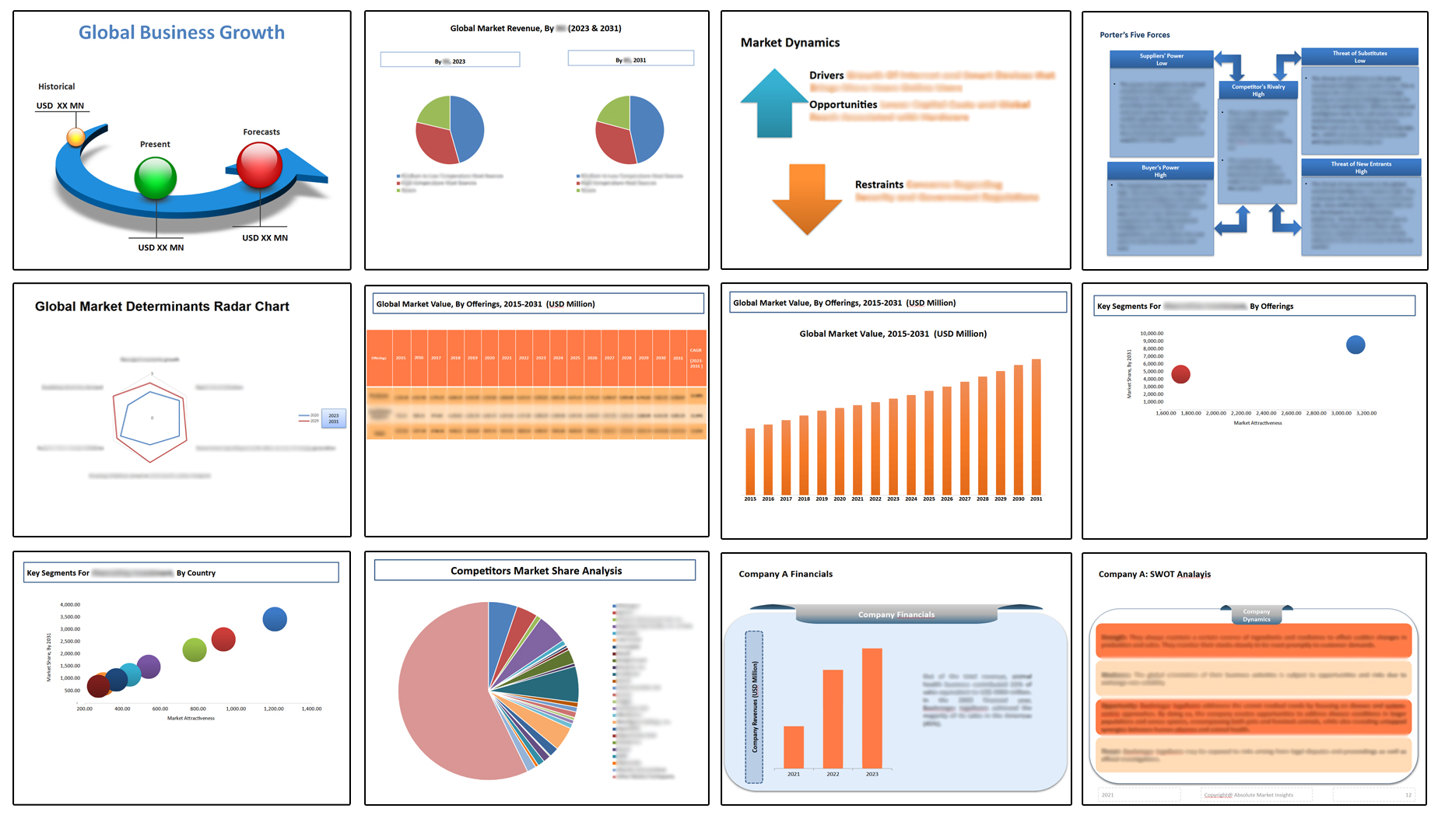Global ENT Devices Market By Product, By End User, By Region & Segmental Insights Trends and Forecast, 2024 – 2034
- Industry: Healthcare
- Report ID: TNR-110-1070
- Number of Pages: 420
- Table/Charts : Yes
- April, 2024
- Base Year : 2024
- No. of Companies : 10+
- No. of Countries : 29
- Views : 10191
- Covid Impact Covered: Yes
- War Impact Covered: Yes
- Formats : PDF, Excel, PPT
ENT (Ear, Nose, and Throat) devices market continues to evolve with advancements in technology and increasing prevalence of ENT disorders worldwide. From diagnostic tools like endoscopes and imaging systems to therapeutic devices such as hearing aids, cochlear implants, and surgical instruments, the market is diverse and dynamic. Factors such as the growing geriatric population, rising awareness about ENT disorders, and technological innovations are driving market growth.
Additionally, the demand for minimally invasive procedures and personalized treatment options further propels the market forward. However, challenges such as stringent regulatory requirements and high costs associated with certain devices may hinder market expansion. Nevertheless, strategic collaborations, product launches, and geographical expansion efforts by key players are expected to sustain growth and foster innovation in the ENT devices market. In terms of revenue, the global ENT devices market was worth US$ 25.3 Bn in 2023 and is anticipated to witness a CAGR of 6.3% during 2024 – 2034.
Global ENT Devices Market Revenue & Forecast, (US$ Million), 2016 – 2034

Growth Drivers Stimulating Global ENT Devices Market
- Continuous advancements in technology have led to the development of innovative ENT devices with improved efficacy, safety, and patient comfort. For example, the integration of robotics, artificial intelligence (AI), and minimally invasive techniques in surgical procedures has enhanced precision and reduced recovery times. Advanced imaging modalities have also enabled more accurate diagnosis of ENT conditions, driving demand for diagnostic devices.
- The rising prevalence of ear, nose, and throat disorders, including hearing loss, chronic sinusitis, and voice disorders, is fueling the demand for ENT devices globally. Factors such as aging populations, environmental factors, and lifestyle changes contribute to the growing burden of ENT conditions. As a result, there is a greater need for diagnostic, therapeutic, and surgical interventions, driving the growth of the ENT devices market.

Hearing aids segment in product dominated the global market with a CAGR of 5.3% during the forecast period. This prominence is primarily attributed to several factors. Firstly, the increasing prevalence of hearing loss, particularly among the aging population, has significantly bolstered the demand for hearing aids worldwide. Additionally, advancements in hearing aid technology, such as digital signal processing, wireless connectivity, and miniaturization, have improved device performance, comfort, and aesthetics, driving adoption rates.
Moreover, rising awareness about hearing health and the importance of early intervention has led to greater acceptance and utilization of hearing aids across diverse demographics. Furthermore, favourable reimbursement policies in many countries and initiatives aimed at reducing the stigma associated with hearing loss have further stimulated market growth. With ongoing research and development efforts focused on enhancing hearing aid features and functionality, the segment is poised to maintain its dominance in the global ENT devices market in the foreseeable future.

Hospital category is the largest revenue contributor in the global ENT devices market in 2023, underscores the critical role hospitals play in the diagnosis, treatment, and management of ear, nose, and throat disorders. Firstly, hospitals are equipped with advanced infrastructure, including diagnostic imaging facilities and surgical theatres, enabling comprehensive care for ENT conditions. Moreover, hospitals often have specialized ENT departments staffed with skilled healthcare professionals, including otolaryngologists and audiologists, who provide specialized care and expertise.
Furthermore, the increasing prevalence of ENT disorders, coupled with the growing demand for surgical interventions and advanced diagnostic procedures, drives the utilization of ENT devices in hospital settings. Additionally, hospitals typically serve as referral centres for complex cases, attracting patients seeking specialized care. With ongoing investments in healthcare infrastructure and technological advancements, the hospital segment is poised to maintain its leading position in the global ENT devices market, ensuring continued access to high-quality ENT care for patients worldwide.
 Europe is positioned to emerge as the second-fastest growing region in the ENT devices market, closely following North America and Asia Pacific. Europe boasts a well-established healthcare infrastructure and a strong focus on research and development, fostering innovation in ENT devices. Moreover, the region’s aging population is driving the prevalence of ENT disorders, increasing the demand for diagnostic and therapeutic devices.
Europe is positioned to emerge as the second-fastest growing region in the ENT devices market, closely following North America and Asia Pacific. Europe boasts a well-established healthcare infrastructure and a strong focus on research and development, fostering innovation in ENT devices. Moreover, the region’s aging population is driving the prevalence of ENT disorders, increasing the demand for diagnostic and therapeutic devices.
Additionally, favourable government initiatives and reimbursement policies in European countries support the adoption of ENT devices, enhancing accessibility to advanced treatment options. Furthermore, strategic collaborations between key market players and healthcare providers facilitate the introduction of novel technologies and products in the region.
With a growing emphasis on patient-centric care and advancements in minimally invasive procedures, Europe is poised for significant growth in the ENT devices market. Continued investments in healthcare infrastructure and regulatory frameworks are expected to further bolster market expansion, ensuring improved ENT care and outcomes for patients across the region.
Competitive Scenario
Key players focus on strategic initiatives such as mergers and acquisitions, product launches, and partnerships to strengthen their market presence. Companies emphasize technological advancements, product innovation, and geographical expansion to gain a competitive edge. Additionally, pricing strategies, regulatory compliance, and customer service play pivotal roles in sustaining market competitiveness. With increasing competition, market players continually strive to differentiate themselves by offering high-quality products and comprehensive solutions tailored to meet evolving customer needs.
Some of the players operating in the global ENT devices market are
- Ambu A/S
- Cochlear Ltd.
- Demant A/S
- GN Store Nord A/S
- Karl Storz SE & Co.
- Nemera
- Nico Corporation
- Olympus Corporation
- Pentax of America, Inc.
- Richard Wolf GmbH
- Rion Co., Ltd.
- Smith & Nephew plc
- Sonova
- Starkey Laboratories, Inc.
- Stryker
- Other Industry Participants
Global ENT Devices Market: Key Highlights
| Report Specifications | Details |
| Market Revenue in 2023 | US$ 25.3 Bn |
| Market Size Forecast by 2034 | US$ 49.5 Bn |
| Growth Rate (CAGR) | 6.3% |
| Historic Data | 2016 – 2022 |
| Base Year for Estimation | 2023 |
| Forecast Period | 2024 – 2034 |
| Report Inclusions | Market Size & Estimates, Market Dynamics, Competitive Scenario, Trends, Growth Factors, Market Determinants, Key Investment Segmentation, Product/Service/Solutions Benchmarking |
| Segments Covered | By Product, By End User |
| Regions Covered | North America, Europe, Asia Pacific, Middle East & Africa, Latin America |
| Countries Covered | U.S., Canada, Mexico, Rest of North America, France, The UK, Spain, Germany, Italy, Nordic Countries (Denmark, Finland, Iceland, Sweden, Norway), Benelux Union (Belgium, The Netherlands, Luxembourg), Rest of Europe, China, Japan, India, New Zealand, Australia, South Korea, Southeast Asia (Indonesia, Thailand, Malaysia, Singapore, Rest of Southeast Asia), Rest of Asia Pacific, Saudi Arabia, UAE, Egypt, Kuwait, South Africa, Rest of Middle East & Africa, Brazil, Argentina, Rest of Latin America |
| Key Players | Ambu A/S, Cochlear Ltd., Demant A/S, GN Store Nord A/S, Karl Storz SE & Co., Nemera, Nico Corporation, Olympus Corporation, Pentax of America, Inc., Richard Wolf GmbH, Rion Co., Ltd., Smith & Nephew plc, Sonova, Starkey Laboratories, Inc., Stryker |
| Customization Scope | Customization allows for the inclusion/modification of content pertaining to geographical regions, countries, and specific market segments. |
| Pricing & Procurement Options | Explore purchase options tailored to your specific research requirements |
| Contact Details | Consult With Our Expert
Japan (Toll-Free): +81 663-386-8111 South Korea (Toll-Free): +82-808- 703-126 Saudi Arabia (Toll-Free): +966 800-850-1643 United Kingdom: +44 753-710-5080 United States: +1 302-232-5106 E-mail: askanexpert@thenicheresearch.com
|
Global ENT Devices Market
Product
- Diagnostic ENT Devices
- Surgical ENT Devices
- Hearing Implants
- Hearing Aids
- Others
End User
- Hospitals
- Ambulatory Settings
- ENT Clinics
- Research And Academic Institutes
- Home Care Settings
- Others
By Region
- North America (U.S., Canada, Mexico, Rest of North America)
- Europe (France, The UK, Spain, Germany, Italy, Nordic Countries (Denmark, Finland, Iceland, Sweden, Norway), Benelux Union (Belgium, The Netherlands, Luxembourg), Rest of Europe)
- Asia Pacific (China, Japan, India, New Zealand, Australia, South Korea, Southeast Asia (Indonesia, Thailand, Malaysia, Singapore, Rest of Southeast Asia), Rest of Asia Pacific)
- Middle East & Africa (Saudi Arabia, UAE, Egypt, Kuwait, South Africa, Rest of Middle East & Africa)
- Latin America (Brazil, Argentina, Rest of Latin America)
Report Coverage

Table of Contents
Note: This ToC is tentative and can be changed according to the research study conducted during the course of report completion.
**Exclusive for Multi-User and Enterprise User.
Global ENT Devices Market
By Product
- Diagnostic ENT Devices
- Surgical ENT Devices
- Hearing Implants
- Hearing Aids
- Others
By End User
- Hospitals
- Ambulatory Settings
- ENT Clinics
- Research And Academic Institutes
- Home Care Settings
- Others
By Region
- North America (U.S., Canada, Mexico, Rest of North America)
- Europe (France, The UK, Spain, Germany, Italy, Nordic Countries (Denmark, Finland, Iceland, Sweden, Norway), Benelux Union (Belgium, The Netherlands, Luxembourg), Rest of Europe)
- Asia Pacific (China, Japan, India, New Zealand, Australia, South Korea, Southeast Asia (Indonesia, Thailand, Malaysia, Singapore, Rest of Southeast Asia), Rest of Asia Pacific)
- Middle East & Africa (Saudi Arabia, UAE, Egypt, Kuwait, South Africa, Rest of Middle East & Africa)
- Latin America (Brazil, Argentina, Rest of Latin America)
The Niche Research approach encompasses both primary and secondary research methods to provide comprehensive insights. While primary research is the cornerstone of our studies, we also incorporate secondary research sources such as company annual reports, premium industry databases, press releases, industry journals, and white papers.
Within our primary research, we actively engage with various industry stakeholders, conducting paid interviews and surveys. Our meticulous analysis extends to every market participant in major countries, allowing us to thoroughly examine their portfolios, calculate market shares, and segment revenues.
Our data collection primarily focuses on individual countries within our research scope, enabling us to estimate regional market sizes. Typically, we employ a bottom-up approach, meticulously tracking trends in different countries. We analyze growth drivers, constraints, technological innovations, and opportunities for each country, ultimately arriving at regional figures.Our process begins by examining the growth prospects of each country. Building upon these insights, we project growth and trends for the entire region. Finally, we utilize our proprietary model to refine estimations and forecasts.
Our data validation standards are integral to ensuring the reliability and accuracy of our research findings. Here’s a breakdown of our data validation processes and the stakeholders we engage with during our primary research:
- Supply Side Analysis: We initiate a supply side analysis by directly contacting market participants, through telephonic interviews and questionnaires containing both open-ended and close-ended questions. We gather information on their portfolios, segment revenues, developments, and growth strategies.
- Demand Side Analysis: To gain insights into adoption trends and consumer preferences, we reach out to target customers and users (non-vendors). This information forms a vital part of the qualitative analysis section of our reports, covering market dynamics, adoption trends, consumer behavior, spending patterns, and other related aspects.
- Consultant Insights: We tap into the expertise of our partner consultants from around the world to obtain their unique viewpoints and perspectives. Their insights contribute to a well-rounded understanding of the markets under investigation.
- In-House Validation: To ensure data accuracy and reliability, we conduct cross-validation of data points and information through our in-house team of consultants and utilize advanced data modeling tools for thorough verification.
The forecasts we provide are based on a comprehensive assessment of various factors, including:
- Market Trends and Past Performance (Last Five Years): We accurately analyze market trends and performance data from preceding five years to identify historical patterns and understand the market’s evolution.
- Historical Performance and Growth of Market Participants: We assess the historical performance and growth trajectories of key market participants. This analysis provides insights into the competitive landscape and individual company strategies.
- Market Determinants Impact Analysis (Next Eight Years): We conduct a rigorous analysis of the factors that are projected to influence the market over the next eight years. This includes assessing both internal and external determinants that can shape market dynamics.
- Drivers and Challenges for the Forecast Period:Identify the factors expected to drive market growth during the forecast period, as well as the challenges that the industry may face. This analysis aids in deriving an accurate growth rate projection.
- New Acquisitions, Collaborations, or Partnerships: We keep a close watch on any new acquisitions, collaborations, or partnerships within the industry. These developments can have a significant impact on market dynamics and competitiveness.
- Macro and Micro Factors Analysis:A thorough examination of both macro-level factors (e.g., economic trends, regulatory changes) and micro-level factors (e.g., technological advancements, consumer preferences) that may influence the market during the forecast period.
- End-User Sentiment Analysis: To understand the market from the end-user perspective, we conduct sentiment analysis. This involves assessing the sentiment, preferences, and feedback of the end-users, which can provide valuable insights into market trends.
- Perspective of Primary Participants: Insights gathered directly from primary research participants play a crucial role in shaping our forecasts. Their perspectives and experiences provide valuable qualitative data.
- Year-on-Year Growth Trend: We utilize a year-on-year growth trend based on historical market growth and expected future trends. This helps in formulating our growth projections, aligning them with the market’s historical performance.
Research process adopted by TNR involves multiple stages, including data collection, validation, quality checks, and presentation. It’s crucial that the data and information we provide add value to your existing market understanding and expertise. We have also established partnerships with business consulting, research, and survey organizations across regions and globally to collaborate on regional analysis and data validation, ensuring the highest level of accuracy and reliability in our reports.









